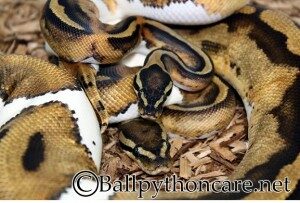Ball python breeding age and weight is a very popular topic online and in the forums. Many self-proclaimed “experts” are very cut and dry when it comes to breeding age and weight. For the most part just about 90% of the care sheets will tell you that a female must be at least 1500grams and a male must be at 750grams. Well, I’m here to tell you this simply isn’t true.
 First off, I have personally produced perfectly healthy clutches of eggs from female ball pythons that have been under 1000grams. The smallest female I have had success with was about an 800gram fire female that gave me a perfect clutch of 5 eggs this season (2012). When it comes to female ball python’s weight there are several factors that have to be taken into consideration to determine if you animal is in breeding condition. Here are the top three factors I take into consideration:
First off, I have personally produced perfectly healthy clutches of eggs from female ball pythons that have been under 1000grams. The smallest female I have had success with was about an 800gram fire female that gave me a perfect clutch of 5 eggs this season (2012). When it comes to female ball python’s weight there are several factors that have to be taken into consideration to determine if you animal is in breeding condition. Here are the top three factors I take into consideration:
1. Age
2. Body tone and condition
3. Current feeding response
Age – Females that are 2 ½ or older generally have a decent chance at producing a viable clutch of eggs even at a weight of under 1500grams, but the older the female the more likely that animal is to be reproductive. Female ball pythons reach sexually maturity between the ages of 18months and in some cases as old as 6-7 years. In my experience most females reach sexually maturity around the 3 year mark, a small percentage will go younger as well as later but the majority will produce around the 3 year mark. Now keep in mind this is feeding the animals very liberally on a consistent basis.
Body tone and condition – You really have to consider the condition of the animal overall, not just what the scale reads. I have 2500gram animals that are clearly too long and thin to be in the breeding program for the year. On the other hand, I routinely have 1200gram females that are short and stocky and are in prime shape for the breeding season. On a side note, I’ve found that these smaller females tend to be a little more consistent when it comes to producing eggs year after year, while the larger females that drop 10 or more eggs take a little more time to recover from the huge loss of body weight. With that, the larger females tend to be every other year breeders.
Current feeding response – This area is often over looked by breeders but it’s an area I like to keep a close eye on as I’ve seen that feeding response directly relates to females producing for the season. I got a female last year in August just before breeding season that was only 800grams. I noticed right away that this female had an extremely aggressive feeding response so I felt very confident putting her on the line even though she wasn’t anywhere near what I’d consider breeding condition. Well, this female continued to feed very aggressively and more than doubled her weight before she laid a 9 egg clutch for me later in the season. This is exactly why I keep a close eye on feeding response as underweight or under conditioned females that have kicked into aggressive feeding mode almost always go on to produce healthy clutches for the season so don’t count those girls so quickly, if so you just may short change your production potential for the year.
Males on the other hand are a totally different story. Male ball pythons become sexually mature  between the ages of 12 weeks old (in some rare cases) to as late as 2 years old. Before you say anything, yes, I’ve bred 12 week old males on more than one occasion and I know of a few other breeders that have done so as well with no ill effects upon the animal. When it comes to weight males readily breed at 400-500grams up to 1200-1500grams but there are those rare cases where males will breed at 300grams and maybe even a little bit smaller but from my experience those real small meals are usually a little on the older side.
between the ages of 12 weeks old (in some rare cases) to as late as 2 years old. Before you say anything, yes, I’ve bred 12 week old males on more than one occasion and I know of a few other breeders that have done so as well with no ill effects upon the animal. When it comes to weight males readily breed at 400-500grams up to 1200-1500grams but there are those rare cases where males will breed at 300grams and maybe even a little bit smaller but from my experience those real small meals are usually a little on the older side.
Feeding response plays a huge role in getting a young male to breed early because if he doesn’t have adequate weight then you shouldn’t even attempt to breed him because he really doesn’t have any weight to spare so the chances of him becoming stressed and dying as a result are much higher. I’ve only ever breed small males that have a great feeding response and all of those 12 week old males that I successfully bred all ended the season with plenty of weight because they continued to feed and grow throughout the season. A little word of advice, if you small male shuts down and refuses to feed during the breeding season, monitor him extremely close or better yet pull him from the breeding program because by the time you realize there’s a problem it may be too late to save him. I’ve personally never bred an animal to death because I’ve been very diligent about monitoring their behavior but I can see where it can happen quite easily if caution isn’t used.